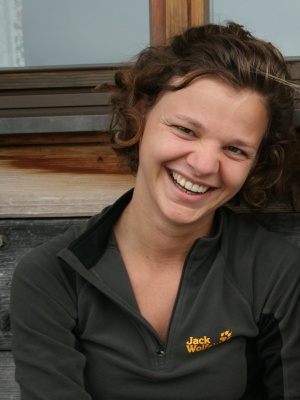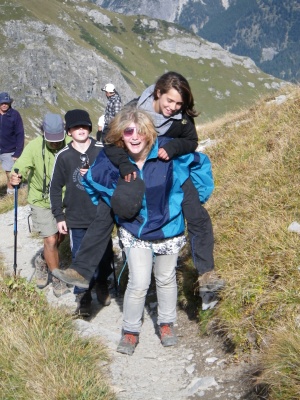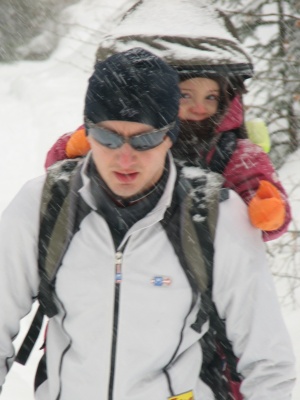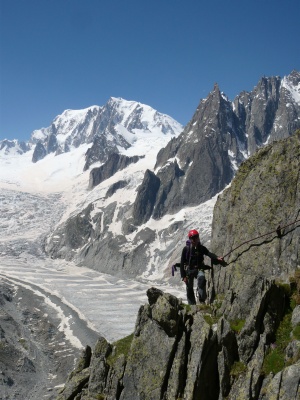The impact of climate change along the Via Alpina, the education of youth with social difficulties through hiking, and a geophotographical inventory of the Red Trail: these are the themes of the three projects selected for the Via Alpina Travel Fellowships 2011 awarded by the Permanent Secretariat of the Alpine Convention, the Via Alpina Secretariat of the Principality of Monaco and the international Via Alpina network:
 Through the “Eyewitness” project, Elisabeth Gsottbauer, Austrian, 27 years, PhD student in environmental policy, environmental economy and behavioural economy at the Autonomous University of Barcelona (Spain), wishes to communicate about the consequences of climate change which are already being felt by the inhabitants of the Alps. During about 10 days in July 2011, she will walk the stages of the Yellow Trail on both sides of Via Alpina’s highest point at Niederjoch pass in Austria (Tyrol) and Italy (South Tyrol). On the way, she will interview farmers, hut keepers, hikers in order to relay their experiences and their vision for the future. PROJECT CANCELLED! Read more >>
Through the “Eyewitness” project, Elisabeth Gsottbauer, Austrian, 27 years, PhD student in environmental policy, environmental economy and behavioural economy at the Autonomous University of Barcelona (Spain), wishes to communicate about the consequences of climate change which are already being felt by the inhabitants of the Alps. During about 10 days in July 2011, she will walk the stages of the Yellow Trail on both sides of Via Alpina’s highest point at Niederjoch pass in Austria (Tyrol) and Italy (South Tyrol). On the way, she will interview farmers, hut keepers, hikers in order to relay their experiences and their vision for the future. PROJECT CANCELLED! Read more >>
 In July too, the 6th-grade class of the special needs school Talander in Wangen im Allgäu (Germany) will start for almost three weeks of hiking from Tschagguns (Montafon, Austria) on the stretch of the Via Alpina Red Trail winding on the Austrian-Swiss and then Swiss-Italian borders, all the way to Tirano. For these 10 boys and 2 girls, aged 13 to 14 years, beyond the physical accomplishment the goal is to develop their social competences: responsibility, team spirit, mutual aid, self-confidence, initiative... just as was experienced last year by a group of Swiss adults (see The therapeutic virtues of Via Alpina). Read more>>
In July too, the 6th-grade class of the special needs school Talander in Wangen im Allgäu (Germany) will start for almost three weeks of hiking from Tschagguns (Montafon, Austria) on the stretch of the Via Alpina Red Trail winding on the Austrian-Swiss and then Swiss-Italian borders, all the way to Tirano. For these 10 boys and 2 girls, aged 13 to 14 years, beyond the physical accomplishment the goal is to develop their social competences: responsibility, team spirit, mutual aid, self-confidence, initiative... just as was experienced last year by a group of Swiss adults (see The therapeutic virtues of Via Alpina). Read more>>
 4 months on the trails, this is what Romain Liagre, French, 32 years, one child, currently project officer at the Support centre to the Bruxelles sector for the help to homeless people “La Strada” will begin in June in order to carry out the project “Photographica alpina”. Combining his competences as a doctor in Geography, his passion for the Alps where he spends most holidays and his talent for photography, he will realise a “geophotographic inventory” of the Red Trail: every 5 km, he will take a picture in each of the four cardinal directions, thus creating a fascinating database for possible future integration in the via-alpina.org website. Upon his return, he will communicate his experience in schools in the Lille area. Read more >>
4 months on the trails, this is what Romain Liagre, French, 32 years, one child, currently project officer at the Support centre to the Bruxelles sector for the help to homeless people “La Strada” will begin in June in order to carry out the project “Photographica alpina”. Combining his competences as a doctor in Geography, his passion for the Alps where he spends most holidays and his talent for photography, he will realise a “geophotographic inventory” of the Red Trail: every 5 km, he will take a picture in each of the four cardinal directions, thus creating a fascinating database for possible future integration in the via-alpina.org website. Upon his return, he will communicate his experience in schools in the Lille area. Read more >>
 Finally, the Selection committee decided to give special mention to the project presented by the French Mountain and Climbing Federation (FFME). Since GTA already provides some organisational help to the realisation of this relay walk through 11 Alpine massifs, punctuated by encounters with other adepts of the whole range of mountain sports, we chose to reserve our financial support to the three projects above. But with this distinction and the inclusion in the group of the Travel fellowships laureates 2011, we wish to underline this project’s professionalism, probably the most ambitious and the one with the largest number of direct participants, and which perfectly reflects the spirit of discovery and encounters of Via Alpina. Read more >>
Finally, the Selection committee decided to give special mention to the project presented by the French Mountain and Climbing Federation (FFME). Since GTA already provides some organisational help to the realisation of this relay walk through 11 Alpine massifs, punctuated by encounters with other adepts of the whole range of mountain sports, we chose to reserve our financial support to the three projects above. But with this distinction and the inclusion in the group of the Travel fellowships laureates 2011, we wish to underline this project’s professionalism, probably the most ambitious and the one with the largest number of direct participants, and which perfectly reflects the spirit of discovery and encounters of Via Alpina. Read more >>
You will soon be able to follow the progress of each of these projects through their respective blogs. Upon their conclusion we will circulate on line and during various events the short films realised along each of these four adventures.
We are also presenting you below the summaries of the other eligible projects which were submitted. Presented by candidates from France, USA, Poland, Germany, Italy and Austria, they deal with artistic, educative or regional development themes with very varied approaches. We would have liked to have enough means to support them too, since each of them at its level brings out a significant enrichment for the Via Alpina. Some will still be carried out, and may receive the moral support of Via Alpina, the Permanent Secretariat of the Alpine Convention and the Via Alpina-Monaco Secretariat.
In the order of submission of the applications:
Martine Keller: Crossing of the Alps >>
“Solo complete crossing of the Alps from Monaco to Trieste through all the countries of the alpine arc, in 4 periods, using most Via Alpina trails (blue, red, green and yellow), followed by the writing of a travel story (in French) published on a website and in paper version by self-publishing or another publishing system.
The project proposed for the contest is one part of a larger program. It is the third period and it is scheduled for July/August 2011. The first and second periods have been carried out in 2009 and 2010 and the last will take place in July/August 2012.”
E-mail: martine.keller67(at)free.fr, web: www.partance.org Fleur and Marie Daugey: Living with wolves: when nature and culture reconcile >>
“Reconciling nature and men is one of the challenges faced by mountain communities. With the return of wolves in the French and Swiss Alps, the question of living peacefully with wild predators has arisen as a difficult one. But solutions exist: associations, volunteers and shepherds work together to preserve traditional alpine farming and give a space to the predator. Like wolves, the Via Alpina crosses borders freely. Hiking this great path is a unique opportunity for us to meet alpine wildlife and cultures. And most of all, show the bonds they are building.”
E-mail: fdaugey(at)yahoo.fr
Agnieszka Kozlowska: Long-distance pedestrian Alpine travel – a Grand Tour of today? Via Alpina installation artwork >>
“I would like to explore from an artist’s perspective, the idea of a long-distance walking trip being a psychological “grand tour” of today, a way of inward travel rather than an outer-oriented one. Through walking the Via Alpina across Switzerland, Liechtenstein, Italy, Austria and Germany, and witnessing the walkers’ culture, I wish to express artistically the psychophysical experience of pedestrian alpine travel, and to communicate this state of mind to the viewer.
I envision creating an installation piece that would represent in a three-dimensional space the cross-section of the trail walked, and the material out of which this would be shaped would be inscribed during the walk with words expressing my subjective experience of the trip at particular moments. This would be complemented by a film expressing the meditative quality of walking, that consists of images of all the trail signs passed on my way that slowly blend one into another.
As an avid walker I have some experience of tackling long mountain routes in various countries. The fellowship would allow me to spend an extended period of time focused on creating a single artwork out of a long-distance route, which is something I have been planning to do for a long time. Alpine pedestrian travel, Via Alpina, Alpine nature and cultures would be promoted internationally by exhibiting the artwork to a wide audience including gallery-goers and visitors to other possible venues where the piece might be displayed.”
E-mail: agnieszka(at)kozlowska.eu, web: www.agnieszkakozlowska.com
Florian Huth: Munich – Mont-Blanc: a photographic walk >>
“Munich, the southernmost large city of Germany, known for upscale lifestyle, Bavarian cosiness and its nearness to the Alps is the perfect starting point to begin my journey through the alpine mountains.
The aim - the Mont-Blanc - the highest mountain of Europe and the dream of many mountaineers is exactly 440.6 km air-line distance away.
Between Munich and the Mont-Blanc are the Alps, the largest mountains of Europe and enormous area for an eminent biodiversity.
Through four countries and over numerous summits, I would like to explore the variety of the Alps by foot and create a large photographic documentation.”
E-mail: mail(at)florianhuth.de, web: www.florianhuth.de
Ursula Achternkamp: Natural Born Bird Watchers >>
“The aim is to make film-portraits of people in the Alpine region. Special people: People which are observing birds. The interview partners will be amateurs, scientists, volunteers out of the Bird Watch Movement. Who are the people supporting the idea of co-existence and biodiversity, what can we learn from birds and what is their motivation for their engagement and how do they integrate this in their daily life.
The Idea is to expand the planer’s view of the “bird's-eye perspective” - to work in-situ with people who are observing birds out of different perspectives. Their personal engagements, their networks for a co-existence of nature and modernity have an important impact for an ecological turn. A research based on the experiences of people will be shown in an artistic documentary + also atmospheric film.”
E-mail: achternkamp(at)bauhaus-dessau.de
Katie Silveria: Alps Culture and Agrarian Living: Sustainable Development along the Via Alpina >>
““The world is a book, and those who do not travel read only a page.” This simple quote, coined by St. Augustine centuries ago, is the motivation for my desire to travel to Europe and trek the Alps. I have travelled in North and Central America but I have never been overseas, certainly not to any place as distinct and historically significant as the Alps. When my partner told me about this one-of-a-kind trail, a trans-Alps, multi-country route, I was instantly intrigued.
I have been aching to travel since graduating from college in 2008 but found myself working instead as a soil science research assistant, a job that has increased my understanding of sustainable agriculture and alternative farming techniques. This knowledge is what drives my Via Alpina project. I believe that one of the most important topics today is sustainable living. I am interested in sustainable development and how it can help preserve rural communities, especially in places where the loss of natural landscapes and cultural traditions would be devastating.
Before starting my trek through the Alps, I would like to research the history of the communities in the Alps and what is being done by organizations like the Alpine Convention to help sustain these groups. I hope to observe regional farming practices, niche markets, and local agro-business and gain an understanding of the connection between sustainable development, such as eco-tourism, and pre-existing Alps culture and economy. I look forward to talking with local people about the changes that are taking place in their regions and how they see their futures being affected by development. I will document and present the information I find and pictures I take on a travel blog and create a short video of my journey when I return.”
E-mail: silveria.katie(at)gmail.com
Marissa Lyons: The Lifestyle of Alpine Living for Young Adults >>
“The purpose of this project will be to explore the effects of alpine living on the culture and psychology of the young adult populations living in the Alps. I am interested in observing how living in remote alpine areas affects the lifestyles of those who live there. I want to investigate how the lifestyles surrounding the Alps will differ from the surrounding cities, villages and countries. For this project I will trek the majority of the Red Trail, interacting with as many people as possible and exploring the environment that undoubtedly affects the way of life of the people who live in it. I also want to practice sustainable travel and learn more about how the populations in the Alps maintain sustainable lives.”
E-mail: mlyons88(at)gmail.com
Andrea Pasqualotto / Mazarol co-operative: Walking through the Alpine Heritage: different properties – a single world >>
“Since 1972 the UNESCO World Heritage Convention, linking together in a single document the concepts of nature conservation and the preservation of cultural properties, recognizes the way in which people interact with nature, and the fundamental need to preserve the balance between the two.
In 1991 the Convention on the Protection of the Alps, recognizing the Alps as a unique, common area, confirmed that the main goal is to develop the common heritage of the Alps and preserve it for future generations through transnational cooperation involving both countries and local authorities, as well as the scientific community, the private sector and the civil society.
According to the same spirit, the trails of the Via Alpina want to facilitate the exchange among lots of different regions, populations and cultures as the alpine ones.
The project “Walking through the Alpine Heritage: different properties – a single world” intends:
- To experience a continuous long-distance hike, called Alpine Heritage Trekking, of about 40 stages, from the Dolomites region (Italy), through the Tectonic Arena Sardona (Switzerland), to the Jungfrau-Aletsch region (Switzerland)
- To enhance the Via Alpina trails as a way to know and appreciate some alpine natural properties inscribed in the UNESCO World Heritage List
- To involve the populations which live close to those properties
- To promote the serial value that results from different properties on a transnational level.”
E-mail: endriupasq(at)hotmail.com
Pauline Lis: Alpine way of life >>
“The Alpine region shared between several European countries represents unique natural and cultural values. The Alpine Convention, and many other Alpine initiatives which promote sustainable development, preservation of its natural beauty and cultural local identities make this region an exemplary one, especially for other multicultural mountain regions in the World.
I would like to experience the cross border hike along the Via Alpina trail, through Germany, Austria, Liechtenstein and Switzerland, explore the natural beauty, the local cultural heritage and visit the most renowned modern alpine architecture - the examples of the innovative sustainable approach and of the best professional practice.”
E-mail: inapaul(at)tlen.pl
Lukas Umgeher, Stefan Mayer, Fabio Richlan: Experience the natural and cultural good Water along Via Alpina >>
“Not just in the central Alps but especially there, water plays a significant role in terms of landscape genesis and settlement by men.
The project is not only dedicated to the importance of water as a distinctive landscape element for instance in form of crystal clear mountain lakes, snow-capped summits and raging rivers but also as a need, opportunity and threat for the people, who live in this unique natural and cultural space in the past as well as in the present.
Selected scenes along the Purple Trail should be described in detail and thus help to raise awareness and to educate the traveling guest as well as the local population in terms of the "precious wet".”
E-mail: stef_mayer(at)hotmail.com, lukas.umgeher(at)gmx.at


 Through the “Eyewitness” project, Elisabeth Gsottbauer, Austrian, 27 years, PhD student in environmental policy, environmental economy and behavioural economy at the Autonomous University of Barcelona (Spain), wishes to communicate about the consequences of climate change which are already being felt by the inhabitants of the Alps. During about 10 days in July 2011, she will walk the stages of the Yellow Trail on both sides of Via Alpina’s highest point at Niederjoch pass in Austria (Tyrol) and Italy (South Tyrol). On the way, she will interview farmers, hut keepers, hikers in order to relay their experiences and their vision for the future. PROJECT CANCELLED!
Through the “Eyewitness” project, Elisabeth Gsottbauer, Austrian, 27 years, PhD student in environmental policy, environmental economy and behavioural economy at the Autonomous University of Barcelona (Spain), wishes to communicate about the consequences of climate change which are already being felt by the inhabitants of the Alps. During about 10 days in July 2011, she will walk the stages of the Yellow Trail on both sides of Via Alpina’s highest point at Niederjoch pass in Austria (Tyrol) and Italy (South Tyrol). On the way, she will interview farmers, hut keepers, hikers in order to relay their experiences and their vision for the future. PROJECT CANCELLED!  In July too, the 6th-grade class of the special needs school Talander in Wangen im Allgäu (Germany) will start for almost three weeks of hiking from Tschagguns (Montafon, Austria) on the stretch of the Via Alpina Red Trail winding on the Austrian-Swiss and then Swiss-Italian borders, all the way to Tirano. For these 10 boys and 2 girls, aged 13 to 14 years, beyond the physical accomplishment the goal is to develop their social competences: responsibility, team spirit, mutual aid, self-confidence, initiative... just as was experienced last year by a group of Swiss adults (see
In July too, the 6th-grade class of the special needs school Talander in Wangen im Allgäu (Germany) will start for almost three weeks of hiking from Tschagguns (Montafon, Austria) on the stretch of the Via Alpina Red Trail winding on the Austrian-Swiss and then Swiss-Italian borders, all the way to Tirano. For these 10 boys and 2 girls, aged 13 to 14 years, beyond the physical accomplishment the goal is to develop their social competences: responsibility, team spirit, mutual aid, self-confidence, initiative... just as was experienced last year by a group of Swiss adults (see  4 months on the trails, this is what Romain Liagre, French, 32 years, one child, currently project officer at the Support centre to the Bruxelles sector for the help to homeless people “La Strada” will begin in June in order to carry out the project “Photographica alpina”. Combining his competences as a doctor in Geography, his passion for the Alps where he spends most holidays and his talent for photography, he will realise a “geophotographic inventory” of the Red Trail: every 5 km, he will take a picture in each of the four cardinal directions, thus creating a fascinating database for possible future integration in the via-alpina.org website. Upon his return, he will communicate his experience in schools in the Lille area.
4 months on the trails, this is what Romain Liagre, French, 32 years, one child, currently project officer at the Support centre to the Bruxelles sector for the help to homeless people “La Strada” will begin in June in order to carry out the project “Photographica alpina”. Combining his competences as a doctor in Geography, his passion for the Alps where he spends most holidays and his talent for photography, he will realise a “geophotographic inventory” of the Red Trail: every 5 km, he will take a picture in each of the four cardinal directions, thus creating a fascinating database for possible future integration in the via-alpina.org website. Upon his return, he will communicate his experience in schools in the Lille area.  Finally, the Selection committee decided to give special mention to the project presented by the French Mountain and Climbing Federation (FFME). Since GTA already provides some organisational help to the realisation of this relay walk through 11 Alpine massifs, punctuated by encounters with other adepts of the whole range of mountain sports, we chose to reserve our financial support to the three projects above. But with this distinction and the inclusion in the group of the Travel fellowships laureates 2011, we wish to underline this project’s professionalism, probably the most ambitious and the one with the largest number of direct participants, and which perfectly reflects the spirit of discovery and encounters of Via Alpina.
Finally, the Selection committee decided to give special mention to the project presented by the French Mountain and Climbing Federation (FFME). Since GTA already provides some organisational help to the realisation of this relay walk through 11 Alpine massifs, punctuated by encounters with other adepts of the whole range of mountain sports, we chose to reserve our financial support to the three projects above. But with this distinction and the inclusion in the group of the Travel fellowships laureates 2011, we wish to underline this project’s professionalism, probably the most ambitious and the one with the largest number of direct participants, and which perfectly reflects the spirit of discovery and encounters of Via Alpina. 
